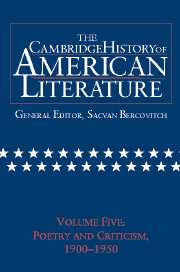Book contents
- Frontmatter
- Introduction
- MODERNIST LYRIC IN THE CULTURE OF CAPITAL
- POETRY IN THE MACHINE AGE
- Prologue
- 1 Gertrude Stein: the poet as master of repetition
- 2 William Carlos Williams: in search of a western dialect
- 3 H. D.: a poet between worlds
- 4 Marianne Moore: a voracity of contemplation
- 5 Hart Crane: tortured with history
- 6 Langston Hughes: the color of modernism
- LITERARY CRITICISM
- Chronology 1910–1950
- Bibliography
- Index
1 - Gertrude Stein: the poet as master of repetition
from POETRY IN THE MACHINE AGE
Published online by Cambridge University Press: 28 March 2008
- Frontmatter
- Introduction
- MODERNIST LYRIC IN THE CULTURE OF CAPITAL
- POETRY IN THE MACHINE AGE
- Prologue
- 1 Gertrude Stein: the poet as master of repetition
- 2 William Carlos Williams: in search of a western dialect
- 3 H. D.: a poet between worlds
- 4 Marianne Moore: a voracity of contemplation
- 5 Hart Crane: tortured with history
- 6 Langston Hughes: the color of modernism
- LITERARY CRITICISM
- Chronology 1910–1950
- Bibliography
- Index
Summary
When The Autobiography of Alice B. Toklas was published in 1933 by Harcourt, Brace and Co. of New York, Gertrude Stein (1874–1946) became instantly famous. At that time, her house in Paris was packed with some of the most innovative of her manuscripts that no publisher wanted to touch. However, Stein's first published book, Three Lives (1909), was generally well received, if only by a limited audience. The book impressed readers for its original handling of language, narrative form, and character, as well as for the mesmerizing effect of its repetitive style. Its first reviewers praised it as “a very masterpiece of realism” with “extraordinary vitality” and “sense of urgent life.” Written, according to Stein's own account, under the influence of Flaubert's Trois contes, which she had been translating, and inspired by Cézanne's portrait of his wife then hanging in Stein's sitting room, Three Lives gathers together three long stories focusing on three working-class women: “The Good Anna,” “Melanctha,” and “The Gentle Lena.” Stein's power of character observation and her ability to capture the speech of common people get the highest praise from Richard Wright, who was later to recount how delighted he was when he first read the story about the black woman, Melanctha. Troubled by “one left-wing literary critic”'s denunciation of Stein as a “decadent” writer, Wright says that he had even read “Melanctha” to “a group of semi-literate Negro stockyard workers” who “understood every word:” “Enthralled,” concludes Wright, “they slapped their thighs, howled, laughed, stomped, and interrupted [him] constantly to comment upon the characters.”
- Type
- Chapter
- Information
- The Cambridge History of American Literature , pp. 194 - 216Publisher: Cambridge University PressPrint publication year: 2003

